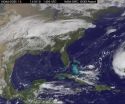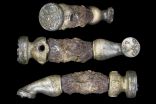(Press-News.org) VIDEO:
This animation of imagery from NOAA GOES-East satellite from Oct. 10-12 shows the movement of Tropical Storm Fay in the Atlantic an approaching cold front over the eastern US....
Click here for more information.
Tropical Storm Fay is affecting Bermuda on Sunday, Oct. 12, but a cold front over the eastern U.S. is expected to absorb the storm over the next day or two. Both were seen in an image from NOAA's GOES-East satellite.
On Saturday, Oct. 11, Tropical Depression 7 became Tropical Storm Fay in the Atlantic. By Oct. 12, Fay was nearing hurricane strength while it was less than 100 miles from Bermuda. NOAA's GOES-East satellite captured an image of the storm.
On Sunday, Oct. 12, Bermuda was placed under a Hurricane Watch and Tropical Storm Warning as Fay neared. NOAA GOES-East satellite provided an image of Fay near Bermuda that showed clouds associated with a cold front over the U.S. that are expected to absorb Fay sometime on Monday, Oct. 13. The image was created by the NASA/NOAA GOES Project at NASA's Goddard Space Flight Center in Greenbelt, Maryland.
At 8 a.m. EDT on Saturday, October 11, 2014, the center of tropical storm fay was located near latitude 27.1 north and longitude 65.2 west. The storm was moving toward the north near 12 mph. Maximum sustained winds were near 60 mph.
Twenty four hours later on Sunday, Oct. 12, Fay's maximum sustained winds were near hurricane-strength at 70 mph (110 kph), although little change in strength is forecast during the next 24 Hours. Fay is expected to become a post-tropical cyclone at night (on Oct. 12).
The center of tropical storm fay was near latitude 33.4 north and longitude 63.9 west, just about 85 miles (140 km) north-northeast of Bermuda. Fay was moving toward the north-northeast near 20 mph (31 kph) and the National Hurricane Center forecasts a turn toward the east-northeast and faster forward movement. On the forecast track, the center of Fay will continue to move away from Bermuda today.
By Monday, Oct. 12, Fay is expected to be absorbed by a cold front.
INFORMATION:
For an updated forecast, visit; http://www.nhc.noaa.gov.
Rob Gutro
NASA's Goddard Space Flight Center
Satellite sees cold front headed to absorb Bermuda's Tropical Storm Fay
2014-10-14
ELSE PRESS RELEASES FROM THIS DATE:
NASA sees newborn Tropical Storm Gonzalo form and threaten Caribbean islands
2014-10-14
Tropical Storm Gonzalo formed quickly on Oct. 12 just east of the Leeward Islands, triggering tropical storm warnings for many islands. NOAA's GOES-East satellite captured an image of the newborn storm on Sunday, Oct. 12, and Tropical Storm Fay northeast of Bermuda.
The GOES East satellite is a geostationary satellite managed by NOAA. At NASA's Goddard Space Flight Center in Greenbelt, Maryland the NASA/NOAA GOES Project creates images and animations and today's visible image, taken at 2:45 p.m. EDT showed a smaller Gonzalvo east of the Leeward Islands while Fay was ...
One gene links susceptibility to rare infections with predisposition to autoimmune disease
2014-10-14
The mutations were familiar, but the patients' conditions seemed baffling at first. A team lead by Rockefeller University researchers had linked variations in an immune gene to rare bacterial infections. Shortly afterward, Chinese scientists told them of three children in that country with mutated versions of the same gene. However, the Chinese children had no history of the severe bacterial infections. Instead, they had seizures and unusual calcium deposits deep in their brains.
This discrepancy led to the discovery of an immune protein with paradoxical roles: It both ...
Antibiotic resistance: Bacterial defense policies
2014-10-14
High-resolution cryo-electron microscopy has now revealed in unprecedented detail the structural changes in the bacterial ribosome which results in resistance to the antibiotic erythromycin.
Multiresistant bacterial pathogens that are insensitive to virtually all available antibiotics are one of the major public-health challenges of our time. The question of how resistance to various antibiotics develops is the focus of research being carried out by Ludwig-Maximilians-Universitaet (LMU) in Munich biochemist Daniel Wilson and his colleagues. As they report in the journal ...
Scientists identify potential cause for 40 percent of pre-term births
2014-10-14
Scientists from Queen Mary University of London (QMUL) and UCL (University College London) have identified what they believe could be a cause of pre-term premature rupture of the fetal membrane (PPROM), which accounts for 40 per cent of pre-term births, and is the main reason for infant death world-wide.
The researchers, whose work was funded by the charity Wellbeing of Women, used bioengineering techniques to test the effect of repetitive stretch on tissues of the amniotic membrane which surrounds and protects the baby prior to birth.
They found that stretching of the ...
Balancing renewable energy costs
2014-10-14
New York | Heidelberg, 13 October 2014 Increasing reliance on renewable energies is the way to achieve greater CO2 emission sustainability and energy independence. As such energies are yet only available intermittently and energy cannot be stored easily, most countries aim to combine several energy sources. In a new study in EPJ Plus, French scientists have come up with an open source simulation method to calculate the actual cost of relying on a combination of electricity sources. Bernard Bonin from the Atomic Energy Research Centre CEA Saclay, France, and colleagues demonstrate ...
Ultra-fast charging batteries that can be 70 percent recharged in just 2 minutes
2014-10-14
Scientists from Nanyang Technological University (NTU Singapore) have developed a new battery that can be recharged up to 70 per cent in only 2 minutes. The battery will also have a longer lifespan of over 20 years.
Expected to be the next big thing in battery technology, this breakthrough has a wide-ranging impact on many industries, especially for electric vehicles which are currently inhibited by long recharge times of over 4 hours and the limited lifespan of batteries.
This next generation of lithium-ion batteries will enable electric vehicles to charge 20 times ...
Older women more likely to have multiple health conditions
2014-10-14
In the context of an aging population, the number of cases of people with multimorbidity, or multiple health conditions, is increasing, creating significant healthcare challenges. Now, the first comprehensive systematic review in this field has found higher levels of multimorbidity in women. Equally as importantly, it has revealed the poor quality of evidence on this increasingly critical area of healthcare.
The review's main author, Professor Jose M Valderas, NIHR Clinician Scientist of the University of Exeter Medical School, is calling for better quality research to ...
Bio-inspired 'nano-cocoons' offer targeted drug delivery against cancer cells
2014-10-14
Biomedical engineering researchers have developed a drug delivery system consisting of nanoscale "cocoons" made of DNA that target cancer cells and trick the cells into absorbing the cocoon before unleashing anticancer drugs. The work was done by researchers at North Carolina State University and the University of North Carolina at Chapel Hill.
"This drug delivery system is DNA-based, which means it is biocompatible and less toxic to patients than systems that use synthetic materials," says Dr. Zhen Gu, senior author of a paper on the work and an assistant professor in ...
Cushing's syndrome: LCSB researchers characterize a new tumor syndrome
2014-10-14
Scientists at the Luxembourg Centre for Systems Biomedicine (LCSB) of the University of Luxembourg have published their findings that mutations in a gene known as "ARMC5" promote the growth of benign tumours in the adrenal glands and on the meninges: ARMC5 appears to belong to the group of so-called tumour suppressor genes. It is the first time in years that scientists have characterized such a gene.
The ARMC5 gene was discovered by independent workgroups studying benign tumours – so-called adrenal adenomas – in connection with Cushing's syndrome. In this ...
University of Leicester archaeologists discover bronze remains of Iron Age chariot
2014-10-14
University of Leicester archaeologists have made a "once-in-a-career" discovery of the decorated bronze remains of an Iron Age chariot.
A team from the University's School of Archaeology and Ancient History has unearthed a hoard of rare bronze fittings from a 2nd or 3rd century BC chariot which appears to have been buried as a religious offering.
The archaeologists found the remains during their ongoing excavation of the Burrough Hill Iron Age hillfort, near Melton Mowbray, Leicestershire.
The School has led a 5-year project there since 2010, giving archaeology students ...







